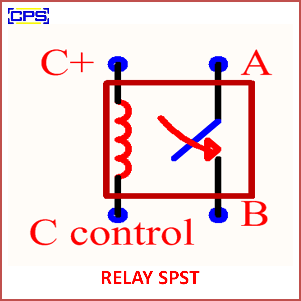A Relay SPST (Single Pole Single Throw) is a basic type of relay that functions as an electrically operated switch with a single input (pole) and a single output (throw). It can either connect or disconnect the circuit when activated, effectively acting like an on/off switch.

Key Features of an SPST Relay
- Single Pole, Single Throw:
- Pole: The input terminal or contact controlled by the relay.
- Throw: A single output terminal connected or disconnected by the relay.
- Operation:
- When the relay is not activated, the circuit is either open or closed, depending on the relay’s type:
- Normally Open (NO): Circuit is open (disconnected) when inactive and closes (connects) when the relay is activated.
- Normally Closed (NC): Circuit is closed (connected) when inactive and opens (disconnects) when the relay is activated.
- When the relay is not activated, the circuit is either open or closed, depending on the relay’s type:
- Control Mechanism:
- Activated by applying a voltage or current to the relay coil, which creates a magnetic field to move the contacts.
Applications of SPST Relays:
- On/Off Control:
- Commonly used for simple switching tasks like turning lights, fans, or other devices on and off.
- Power Distribution:
- Used in circuits to control the flow of power to a load from a single input source.
- Automation Systems:
- Frequently used in home automation and industrial control systems for basic switching operations.
Advantages:
- Simple design and easy to use.
- Provides electrical isolation between control and output circuits.
- Cost-effective and widely available.
Disadvantages:
- Limited functionality compared to multi-throw relays (e.g., SPDT).
- Electromechanical relays are prone to wear over time.
- Slower switching speeds compared to solid-state relays.
